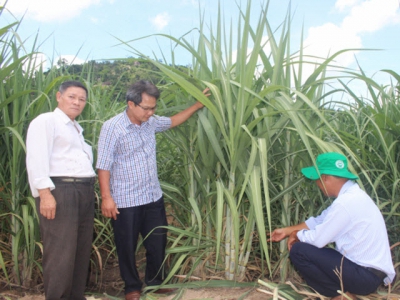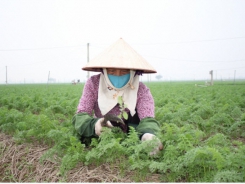Reclaiming the position of sugar cane plant

After a long decline, the price of sugar cane has returned to normal. Thus, Phu yen farmers may concentrate their efforts on sugar cane cultivation, particularly intensive farming.
In many sugarcane areas in Phu Yen, people are focusing on investing in intensive farming and re-scaling up the sugarcane area. Photo: Hoai Nam.
Additionally, the competent agencies are undertaking strategies to invest in infrastructure, most notably expanding sugar cane growing areas for active irrigation.
Restored planting area
According to the Phu Yen Department of Agriculture and Rural Development, sugar cane is the province's primary force plant, providing steady incomes for residents and contributing to poverty eradication and rural development. By June 2021, the total sugar cane area was around 22,000ha, with a total output of 57.4 tons per ha. The districts of Son Hoa, Song Hinh, Dong Xuan, Tuy An, Tay Hoa, and Phu Hoa are the primary material areas.
Concurrent with the decline in sugar cane prices, the province's planting area has steadily decreased over the last several years, from 27.949 ha in 2017 to 21.601 ha in 2020. Among the factors were the effects of climate change (drought in 2019) and the complicated development of the Covid-19 pandemic since 2020. However, the Phu Yen sugar cane factory continues to assure the projected area by supplying adequate material for the province's sugar plants.
According to Ms. Nguyen Thi Truc Mai, deputy director of the district's Agriculture and Rural Development Office, sugarcane is the district's primary crop, although the planting area has declined in recent years. Farmers in the area planted and preserved 1,597.5 ha of sugarcane in the crop year 2021-2022 (as planned, 2,000 ha). Farmers gathered around 1,000 hectares of sugarcane in the 2020-2021 crop year, generating 50 tons/ha.
Son Hoa district is the province's major raw material region for sugar cane. The district as a whole planted over 9,600ha in the 2020-2021 crop year. Mr. Ralan Thu of Tan Hien village (Son Phuoc commune) noted that his family has been cultivating sugarcane for more than 20 years. Sugarcane is the primary crop of the Son Phuoc people due to the presence of a sugar mill that sells goods and provides employment for residents.
However, between 2017 and 2019, the price of sugarcane continued to fall, and 1 hectare of around 65 tons of sugarcane was only sold for around VND 45 million, minus the break-even cost. In years of dry weather, particularly in 2019, several places only reached 60% production, resulting in losses and debts for many farmers, who were forced to abandon sugarcane and migrate to other crops.
According to Mr. Pham Dinh Phung, Vice Chairman of the Son Hoa District People's Committee, the district's sugarcane area grew to 16,000 hectares in the 2017-2018 crop year, and many people prospered as a result of sugarcane. However, when the local sugar price fell drastically in the 2018 – 2019 timeframe, sugar manufacturers were forced to purchase at a price of VND 700,000 – 750,000 per ton.
Farmers earn no profit, or even take a loss, at this price. Drought also lowered sugarcane yields during this time period; farmers were uninterested in cultivating sugarcane, and the area was reduced to around 8,000 hectares. In the 2020-2021 crop year, the price of sugarcane rose relative to previous years; the price of sugarcane bought in the field was VND 1,040 per kg, and as a result, farmers around the district planted almost 9,600 hectares, but have yet to recapture the same area as before.
Over VND 1 trillion investment in irrigation to restore sugar cane
Phu Yen's sugar cane material regions are mostly located on high steep terrain where production conditions are still substandard and it is difficult to employ synchronous intensive or rotational, intercropping farming techniques.
The irrigation infrastructure in the province has not yet reached the standards for sugarcane cultivation. The majority of the sugarcane-producing area is dependent on the sun, and planting timing is dependent on the weather.
According to Mr. Truong Van Tuan, Director of the Phu Yen Agricultural Extension Center, the Center, the Sugar Research Institute, and sugarcane companies throughout the province conduct annual testing, import, and selection of new sugarcane varieties suitable for local farming conditions to gradually replace degraded sugarcane varieties. These units collaborated on the implementation of intensive investment models for sugarcane with irrigation water as a foundation for future replication.
Mr. Dao Ly Nhi, Deputy Director of the Phu Yen Department of Agriculture and Rural Development, shared that while the majority of sugarcane raw material is grown in the three mountainous districts of Song Hinh, Son Hoa, and Dong Xuan, some areas in other districts grow sugarcane in hilly areas without irrigation, making it difficult to apply intensive farming, crop rotation, and intercropping measures synchronously, resulting in productivity loss.
Irrigation and transportation infrastructure are also restricted in the sugarcane material region. That is why sugarcane farmers abandon sugarcane when they perceive alternative crops capable of providing a greater economic return. To enable farmers and farmers to "live" with sugarcane, it is required to enhance financial assistance for road and irrigation system maintenance and renewal. There are efficient mechanisms in place to incentivize farmers to maximize the usage of irrigation works invested in watering sugarcane material regions.
Mr. Tran Huu The, Deputy Secretary of the Provincial Party Committee and Chairman of the Phu Yen Provincial People's Committee, said that the Provincial People's Committee would find solutions for irrigation in-field infrastructure. The province intends to spend VND 1,000 billion on irrigation for specialized cultivation of sugarcane and other crops, including the construction of new lakes, the repair of dams, the expansion of irrigation water areas, and the provision of high wages to sugarcane producers.
Related news
Tools

Phối trộn thức ăn chăn nuôi

Pha dung dịch thủy canh

Định mức cho tôm ăn

Phối trộn phân bón NPK

Xác định tỷ lệ tôm sống

Chuyển đổi đơn vị phân bón

Xác định công suất sục khí

Chuyển đổi đơn vị tôm

Tính diện tích nhà kính

Tính thể tích ao



 Large field production model helps Ninh Thuận farmers…
Large field production model helps Ninh Thuận farmers…  Organic agriculture - a gift of the mother…
Organic agriculture - a gift of the mother…